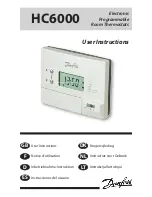
39
13.6.1.4 Setting the input deactivation time
This setting enables defining a time interval for deactivating the input� The chronothermostat detects
the state of deactivation only when the alarm condition has not been detected for at least the entire
duration of the set deactivation time�
For setting the input deactivation time send the following SMS message:
<user code>.I1.TOFF.<time>
where
<time>
is the time of deactivation, expressed in ms (milliseconds)�
Note
: No response SMS message is required from the chronothermostat 01913�
Example�
If the set user code is the default 1234 and you want to set a deactivation time of 2 s, send the
following SMS:
1234.I1.TOFF.2000
13.6.1.5 Associating the alarm with the telephone numbers where the SMS message is to be sent
This setting enables associating the SMS alarm message with up to 8 telephone numbers to which
the message must be sent�
The procedure requires no response from the chronothermostat 01913�
Send the following SMS message:
<user code>.SMSAI.NUM.<n1...n8>
where
<n1...n8>
is the list of indices of the phone numbers for associating the input alarm
SMS message�
Example�
If the set user code is the default 1234 and you want to associate the SMS input alarm message with
the phone numbers of index 1, 2 and 5, send the following SMS:
1234.SMSAI.NUM.125
To read the associations between all the types of alarm messages and telephone numbers, send the
following SMS:
<user code>.?SMS
The chronothermostat 01913 will send a response SMS message with the list of all the associations
between the phone numbers and the types of SMS alarm messages:
















































